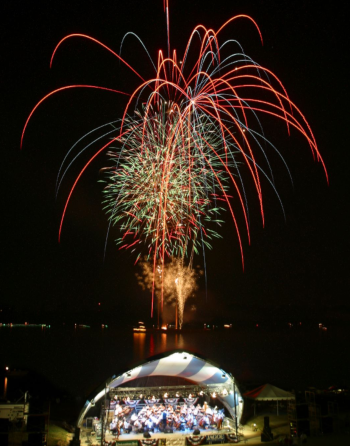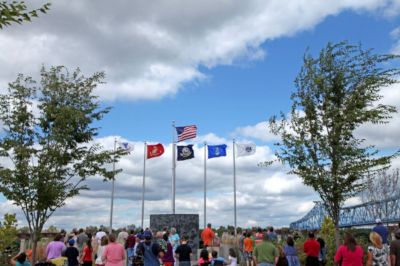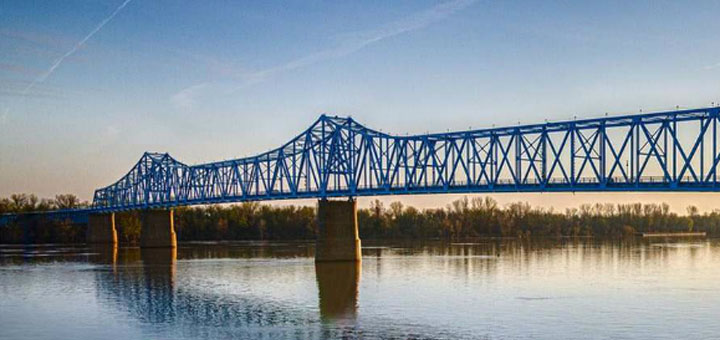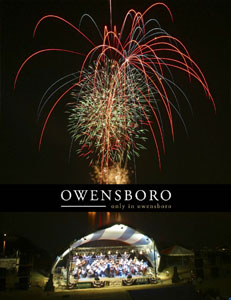Business View Magazine profiles the city of Owensboro, Kentucky , with a population of 58,000 in Northwestern Kentucky on the banks of the Ohio River.
Only in Owensboro
Owensboro, Kentucky couldn’t have a more enthusiastic booster than its mayor, Ron Payne. “What is happening in this community is phenomenal,” Payne says, when talking about the explosion of public and private revitalization of this city of 58,000 on the banks of the Ohio River. “We were a sleepy, little old town here in Kentucky that has come alive. We are on the move like never before in the history of this community. All of the things have happened in the last seven years.”
 Payne exults about the attention that his city is now getting because of its successful and ongoing renaissance. “We are being looked at from around the country,” he exclaims. “In 2013, for the first time in over 50 years, we got designated as an ‘All-American City.’” Every year, the National Civic League recognizes and celebrates the best in American civic innovation with its prestigious All-America City Award. Ten communities from across the nation are chosen from more than 500 applicants. Owensboro’s last award was in 1952. “In fact, we have people coming here from all over the world,” Payne adds, proudly.
Payne exults about the attention that his city is now getting because of its successful and ongoing renaissance. “We are being looked at from around the country,” he exclaims. “In 2013, for the first time in over 50 years, we got designated as an ‘All-American City.’” Every year, the National Civic League recognizes and celebrates the best in American civic innovation with its prestigious All-America City Award. Ten communities from across the nation are chosen from more than 500 applicants. Owensboro’s last award was in 1952. “In fact, we have people coming here from all over the world,” Payne adds, proudly.
How did this remarkable resurgence come about in the “sleepy” Kentucky town? Payne talks about the early days of his first term: “When I got elected mayor, before I took office, I had a chance to meet with some of my commissioners,” he begins. “And all of us said ‘It’s time that we move this community forward.’ We were doing nothing, downtown. They were boarding up our downtown. We were not taking advantage of our location on the Ohio River. We were spiraling downward and all of these elected officials agreed that we were going to take bold action. We were going to do what was necessary to move this community forward.”
Payne and his commissioners understood that in order to see their vision through, they would 1) have to have a plan; 2) figure out a way to pay for it; and 3) succeed at selling that plan to the public and other necessary allies and stakeholders. Regarding number one, Payne took a lesson from much older cities he had been in that had vibrant and bustling downtowns. “I travelled a little bit in Europe, before I became mayor, and I noticed these areas in Paris, and Prague, and Vienna, where people come to ‘gather and gab,’ I call it.” Based on those models, Owensboro’s downtown created plans to make itself very walkable with dining and entertainment venues, and the ability to wander between the city core and the riverfront, unimpeded by traffic.
Number two was going to be risky. Paying for the plan is always the hard part – but also the most necessary. “I think, first and foremost, you can have public hearings, and you can talk and study, but you have to be willing to step out and take risk,” Payne says. “That’s not something politicians are good at. But you have to be a little bit of a risk taker. In the private sector, they can take risks with their own money. Public officials have to be a little careful about that because we’re not risking our own money, we’re risking somebody else’s. But, at times, you do have to do that.”
Payne took the first risk, himself. “When I took office, we were in the middle of the Great Recession. And three days after I took office, I proposed increasing our insurance tax from four percent to eight percent to pay for all this. And I thought that six months after I did that, they were going to be looking in the Ohio River to find my body.” But for Payne, personally, the risk has apparently been worth it. “There were some people that fussed about it, but there were a lot of people who wanted something done. I actually intended to run for one term,” he admits. “But when I ran for re-election, I ran unopposed.”
Nonetheless, Payne is cognizant that that number three must always a team effort. “As mayor, I can’t do anything on my own,” he says. “And I can’t say enough about my comrades. They stepped up – right in the middle of the recession. But we all agreed it was the best time to do it because we created our own stimulus program here; we put all these people around here to work and all the contractors were very hungry. We got the chamber behind us; we got the county government behind us; we got our economic development folks behind us; we got the newspaper behind us; everybody was ready for something to happen. We couldn’t have found a better time, in my opinion, because while everybody else was doing nothing, we were very busy. I said when this recession is over with, we’re going to come out of it ready to compete with the rest of the world. And that is what’s happened.”
 Payne likes the idea of Owensboro being a competitive city. In fact, he believes that every city is competing for both residents and businesses. “I start a lot of my discussions, when I go places, with ‘Owensboro, comma, Incorporated.’ We’re a business,” he asserts. “I’ll talk to cities and I’ll tell them, straight out, ‘you have to understand something: I’m competing with you. I want the young people to come to Owensboro. I want them to stay here. I want businesses to come here. I don’t want them to come to your city. I want them to come to mine. So, I’m going to do what is necessary to build a tremendous product, here, that people are going to want to buy into.’ We’re selling our city. We’re competing.”
Payne likes the idea of Owensboro being a competitive city. In fact, he believes that every city is competing for both residents and businesses. “I start a lot of my discussions, when I go places, with ‘Owensboro, comma, Incorporated.’ We’re a business,” he asserts. “I’ll talk to cities and I’ll tell them, straight out, ‘you have to understand something: I’m competing with you. I want the young people to come to Owensboro. I want them to stay here. I want businesses to come here. I don’t want them to come to your city. I want them to come to mine. So, I’m going to do what is necessary to build a tremendous product, here, that people are going to want to buy into.’ We’re selling our city. We’re competing.”
Interestingly, it was the exact opposite of competition that enabled Owensboro to launch its revitalization in the first place. In fact, it was many levels of cooperation that needed to take place in order to make things happen – starting with the city’s own leadership. Payne believes that Owensboro’s governmental structure helped to foster that first level of cooperation. “We have no partisan politics in our government,” Payne explains. “I don’t run as a Democrat or a Republican or anything else. All of our elections, all of our office holders, are non-partisan. I can’t even tell you what party my commissioners belong to. And when we look around the country, with all this fussing and fighting that goes on, not only in Washington, but even in state capitals, it’s a wonder they get anything done. Our people on our commission are concerned about one thing: what’s in the best interest of the City of Owensboro, not their political careers.”
Once the city administration had its plans in place, and there was a dedicated source of funding, the building and spending commenced. “We spent $100 million of government money to start all of the projects in our downtown,” Payne says. And once the public monies began to flow, the private dollars began to follow. “It was not only the tax – the tax primed the pump. After that, a lot of it was the private sector. The entrepreneurs we have in this community are fabulous and they continue to invest. I think by the time the summer is over, that the private sector will have put in $200 million.”
The scope of Owensboro’s urban revival is truly impressive. One major project has been the redevelopment of a 1.4 mile stretch of the city’s Riverfront district. By the summer of 2012, the city had created more than 15 acres of public, recreational space along the water’s edge, including a five-block space that became Smothers Park – built on land reclaimed from the riverbank during construction, and featuring playgrounds, fountains, water features, and a veteran’s memorial.
“We just built a brand new convention center,” adds Payne. “And we now have two hotels – one on either side of it. We have a new, major office building, downtown. We’ve built a $408 million state-of-the-art, award-winning hospital (Owensboro Health Regional). And the hospital is the largest employer in Kentucky, west of Louisville. We built a new indoor ice arena; we built a new outdoor tennis facility.”
In order to carry out its plan to make the city core more pedestrian-friendly, Owensboro convinced the state to give it the right to re-route U.S. 60, which used to run through downtown. “We routed U.S. 60 around our bypass,” Payne explains, “so that we could ensure that our downtown and riverfront would never be separated by highway. We took that road, and we squeezed it by expanding the sidewalk so we could have a lot of downtown dining outside and the opportunity for people to walk up and down our downtown and our riverfront.”
And the redevelopment shows no signs of slowing down. Payne continues: “This summer, we have four major projects that are going on. Right along the river we had an old American Legion that was bought by some developers and we’re going to put in a five-story building with retail on the first floor, offices on the second, and then three floors of condos. We’ve got an old restaurant that’s coming down and the developers are going to put up a four-story building with two restaurants on the first floor. Right across the street from that, we’re getting ready to build the International Bluegrass Music Center and Museum. The state of Kentucky helped us a little bit with that, but most of it was private.”
Another area ripe for redevelopment is the so-called “Highway 54” section in the southern part of the city that Payne says is “exploding with retail growth. We’ve been able to get the state to turn this into a TIF district (Tax Increment Financing). The anticipated tax growth coming from the project is used to finance it. The consultants from the state estimated that this project, over the next twenty years, will generate $158 million. We’re looking at building a road out there that will connect that area to the hospital area. We’re also looking at building a new sports arena out there for the NHL Hockey team that just moved out of Evansville, over here.”
In order to increase access to the new Owensboro, Payne says the city worked with the state and federal governments to help link it up with the Interstate Highway system. “We’ve got a parkway that comes here that we’re going to put on the Interstate system – a part of I65,” he says. “We’ve got another parkway that goes west that will hook up with I69, and that will also become an interstate spur. I’ve always said it’s critical that we get on the Interstate system, and now, it looks like we’re going to do that.”

All of the new construction and redevelopment in Owensboro has only added to the city’s existing amenities, which includes a vibrant arts community. “We have the Owensboro Symphony. We’ve got a Performing Arts Center; it’s beautiful and right on the river,” says Payne. “We have a Fine Arts Museum; we’ve got a Science Museum. The arts are very important to me. About a year or so ago, I started a program to put sculptures throughout our downtown. We invited artists to come in and present their materials to us and we gave the community an opportunity to select pieces. The artists had agreed to rent their art to the city at the price of $2,500 a year, for two years. If we like it, or a business likes it, we have an opportunity to buy it; otherwise, we change it out. Most of it’s been bought.”
Payne believes that the city’s new initiatives are luring both newcomers as well as old-timers. “It’s a different city than it was seven years ago, and a lot of people are wanting to come back here – people who grew up here and moved away. Young people are really excited. We have three colleges and a community college. We’ve got Brescia University, a Catholic school; we’ve got Kentucky Wesleyan; and we’ve got a campus of Western Kentucky University, here. And we’re going to do everything we can to keep them here.”
In the end, Payne emphasizes the necessary prescription for any city’s successful regeneration – not only Owensboro. It’s having a vision, taking risks, selling the vision, and forming the partnerships that ultimately get things done. “You have to have a vision and you have to be able to sell it to people,” he says. “But we’ve been successful because of our partnerships – with the public, with the business people – bold leadership on the part of the elected officials, but also the community stepping up to form partnerships to make these things happen.”
AT A GLANCE
WHO: Owensboro, Kentucky
WHAT: A city of 58,000
WHERE: : Northwestern Kentucky on the banks of the Ohio River
WEBSITE: www.owensboro.org
PREFERRED VENDORS

DIG DIGITAL?




